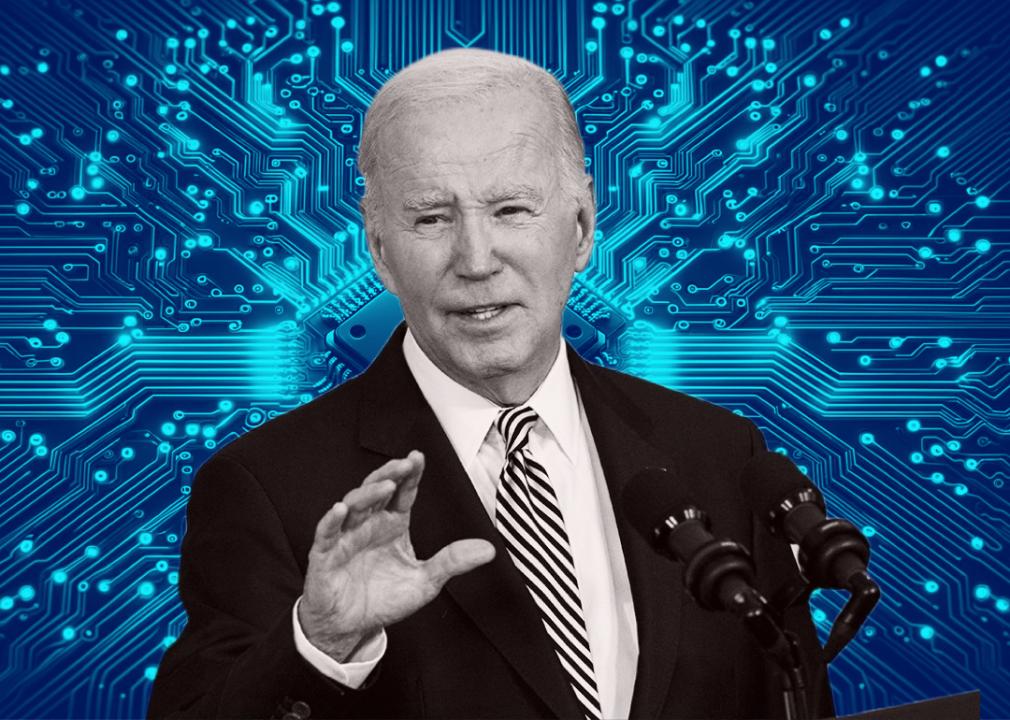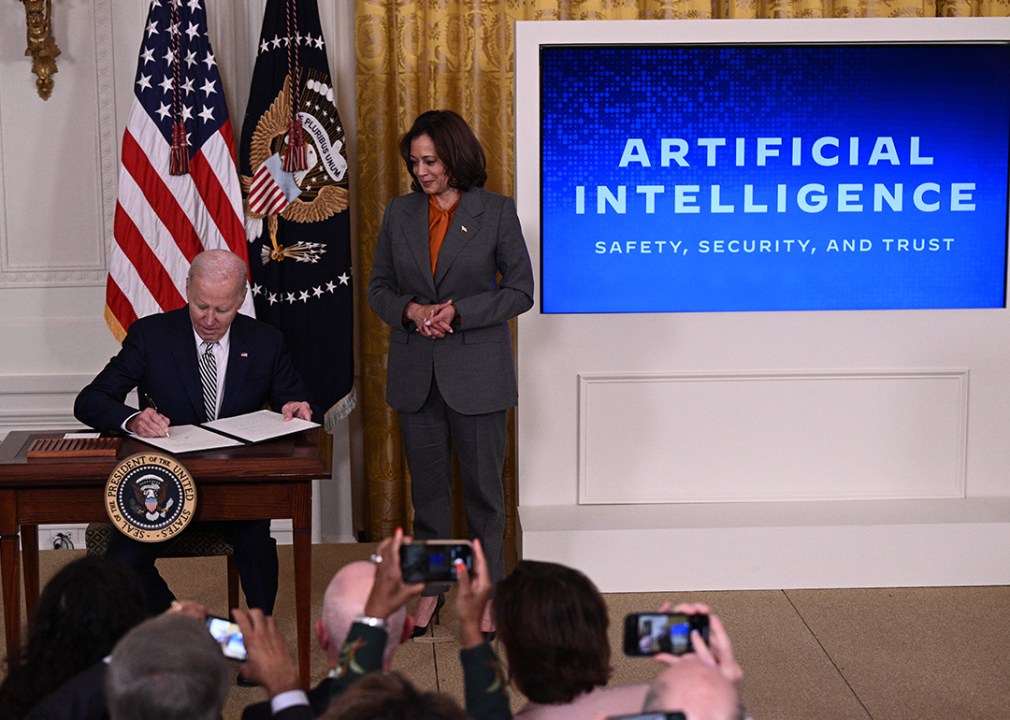What the Biden administration's new executive order on AI will mean for cybersecurity

Photo Illustration by Stacker // Getty Images
What the Biden administration’s new executive order on AI will mean for cybersecurity
US President Joe Biden delivers remarks in the White House with blue processor graphic in background.
Regulations have been proposed by a presidential administration committed to a responsible rollout of one of the most consequential technologies since the advent of the internet.
The adoption of AI products accelerated rapidly over the past year since OpenAI released its large language model-powered chatbot, ChatGPT. Today, the generative AI platform boasts more than 100 million weekly users worldwide and is used by developers at 9 in 10 Fortune 500 companies.
In that time, academics, researchers, and even the CEOs of companies producing AI tools themselves have called for guidance and responsible safeguards for AI. Among their concerns are the displacement of workers; violations of copyright law; furthering wealth inequality in financial services, as well as dissemination of discrimination and misinformation; and national security in a world where other global powers have access to AI as well.
Drata reviewed the Biden administration’s 48-page executive order on AI and analyses from law firms and researchers to identify the proposals most likely to affect U.S. cybersecurity.
The order has been described as “sweeping” by academics because it proposes regulations for using AI in the federal government and managing risks to privacy, consumer protections, national security, and civil and human rights in both the public and private sectors.
The Biden administration said it not only wants to prevent harm but promote a responsible development of AI tools that will keep the U.S. at the forefront of what’s been dubbed the
“AI arms race.” On that front, the order aims to “maximize the benefits of AI” for working Americans, expand grant funds for AI research, attract workers who can work on advanced AI systems, and hire AI professionals into federal agencies.
![]()

BRENDAN SMIALOWSKI/AFP via Getty Images
A benchmarking initiative from the Departments of Commerce and Energy
US Vice President Kamala Harris looks on as US President Joe Biden signs an executive order.
The Department of Commerce is the federal agency implementing and overseeing many of the executive order’s new rules and regulations. The department’s National Institute of Standards and Technology released its Artificial Intelligence Risk Management Framework in January 2023 for developing and deploying AI systems responsibly within the government, which can be used voluntarily by the private sector.
The executive order has given the Department of Commerce nearly a year to expand on its NIST framework and create a version for generative AI products like ChatGPT and Google’s Gemini model. The order will also launch an initiative to create standards for how companies and the government should audit AI systems to determine cybersecurity risks.

Gorodenkoff // Shutterstock
Training record transparency
Person with laptop and security badge in digital monitoring room.
The Department of Commerce will also require private companies to turn over to the government records from AI training processes for advanced models considered “dual-use foundation models.” AI is developed by feeding an algorithm large amounts of data, which it can learn from, cite when answering prompts, and use to generate media or perform a task.
The administration’s executive order defines “dual-use” as an AI model “trained on broad data; generally uses self-supervision; contains at least tens of billions of parameters; is applicable across a wide range of contexts; and that exhibits, or could be easily modified to exhibit, high levels of performance at tasks that pose a serious risk to security, national economic security, national public health or safety, or any combination of those matters.”
The executive order states that the government is particularly concerned with how those models might make it easier to develop weapons of mass destruction, enable “powerful” offensive cyberwarfare capabilities, and become difficult for humans to control once unleashed.

Gorodenkoff // Shutterstock
Annual CISA risk reports
Person reviewing information on computer screen.
Importantly, the order also lays the groundwork for protecting critical infrastructure around the country from cyberattacks via vulnerabilities in AI models. Any agency overseeing critical infrastructure, like the Department of Energy, will be required to meet with the Cybersecurity and Infrastructure Security Agency director at least once a year to report risks posed by AI.

katjen // Shutterstock
Treasury Department best practices for managing cybersecurity in financial institutions
Financial stock exchange market display screen board.
The part of the order focused on risk reporting with CISA also requires the Treasury Department to pull together and share best practices for financial institutions trying to mitigate cybersecurity risks posed by AI systems.
In an August 2023 report, the International Monetary Fund found that AI models pose an inherent risk to customers’ data privacy, civil rights, and financial security. Financial institutions like banks are vulnerable to phishing attacks and identity theft that could become much more sophisticated and aggressive with the adoption of generative AI. The report also detailed the risks posed by institutions using AI to do things previously performed by humans, like profiling them for risk before lending them money, which could result in discriminatory lending decisions.

Canva
Potential regulations for using AI in health care settings
Stethoscope in blue light.
Over the next year, an AI task force made up of the secretaries of the Departments of Defense, Veterans Affairs, and of Health and Human Services will develop policies for the responsible deployment of AI in the health care sector. It would include AI systems that might be used for new drug discovery, health care devices, public health initiatives, and care financing. The order instructs those department heads to propose regulatory action “as appropriate.”
The order specifically calls out the need for guidance on how software security standards can be updated to protect personally identifiable information maintained by companies in the sector. The health care sector is one that stands to benefit greatly from the advancement of technology and is also among the most targeted by cyberattacks.

FAMILY STOCK // Shutterstock
Incorporation of AI in federal government operations with CISA guidance
Person working with AI.
The federal government isn’t planning to sit on the sidelines and merely set the rules for the rest of the players. It, too, is interested in deploying and using AI for its own operations. The order explicitly discourages government agencies from “imposing broad general bans or blocks on agency use of generative AI.” Instead, it encourages limiting their use based on risk assessments of each specific tool.
That will mean, in part, establishing a position at each agency known as the Chief AI Officer. Those heads and their agencies will be provided with recommendations by the Office of Management and Budget for navigating the implementation of AI responsibly while factoring in practical limitations like budgets, workforce training, and necessary cybersecurity processes. Agencies will also receive recommendations for how to conduct “red teaming” on generative AI systems—the process of trying to exploit the weaknesses of a system in an adversarial way to learn how to defend it better.
Story editing by Jeff Inglis. Copy editing by Paris Close.
This story originally appeared on Drata and was produced and
distributed in partnership with Stacker Studio.
